Imagine stepping outside to pick crisp lettuce or juicy tomatoes for tonight’s dinner. That dream is closer than you think—even without prior experience. A few simple steps can turn any space into a thriving source of fresh, chemical-free meals.
In 2020, I transformed my barren lawn into a productive garden. The rewards? Ultra-fresh food, lower grocery bills, and the joy of nurturing plants. You don’t need a green thumb—just enthusiasm and basic guidance.
This guide covers essentials like preparing soil, choosing the right seeds, and simple maintenance. Whether you have a backyard or just a balcony, options like raised beds make it accessible. Plus, you’ll savor meals within weeks.
Gardening isn’t just productive—it’s therapeutic. Ready to dig in?
Why Choose Organic Gardening?
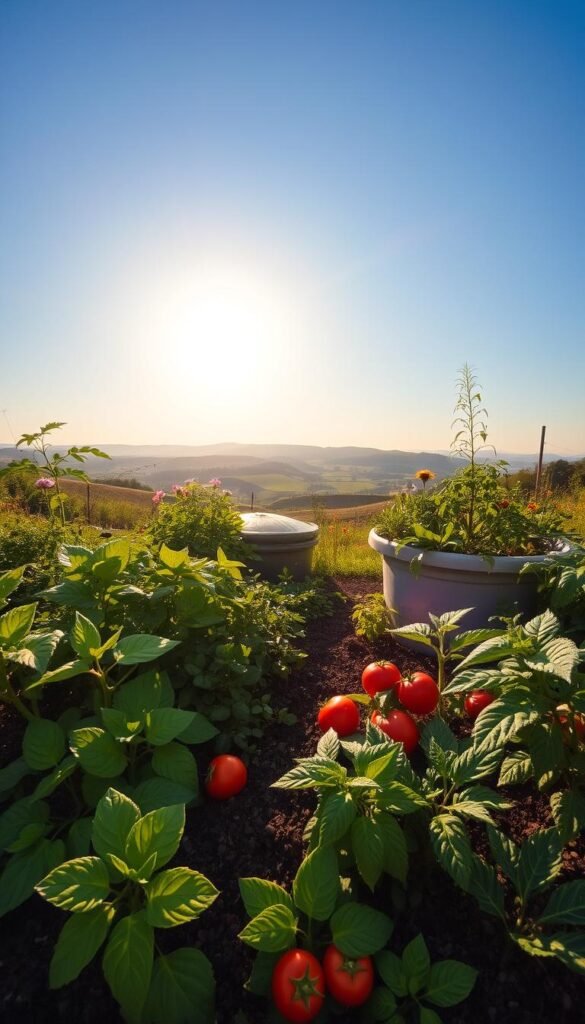
Fresh, flavorful, and free from harmful chemicals—that’s what you get when you grow your own food naturally. Unlike store-bought produce, which travels miles and loses nutrients, homegrown harvests pack maximum vitamins and minerals. Plus, you control what goes into your garden, ensuring zero synthetic pesticides.
Healthier Meals, Happier Planet
Studies show conventional farming strips up to 40% of nutrients from crops. Organic methods preserve these vital compounds. Think vibrant tomatoes bursting with lycopene or leafy greens rich in iron.
Your lawn transforms into a nutrient factory. Kitchen scraps become compost, feeding plants in a closed-loop system. No waste, just abundance.
Organic vs. Conventional: What’s the Difference?
USDA organic standards ban synthetic fertilizers and toxic sprays. This means:
- Food tastes better (compare a homegrown carrot to a grocery-store one)
- Soil stays healthy for years, not just one season
- Bees and butterflies thrive without chemical threats
| Factor | Organic | Conventional |
|---|---|---|
| Nutrient Density | Higher (peaks at harvest) | Lower (degrades during transport) |
| Soil Health | Improves over time | Depletes without synthetic inputs |
| Cost | Lower long-term | Higher recurring expenses |
Methods like no-dig gardening boost soil matter naturally. Your plants grow stronger while you reduce your environmental footprint—one harvest at a time.
Picking the Perfect Spot for Your Garden
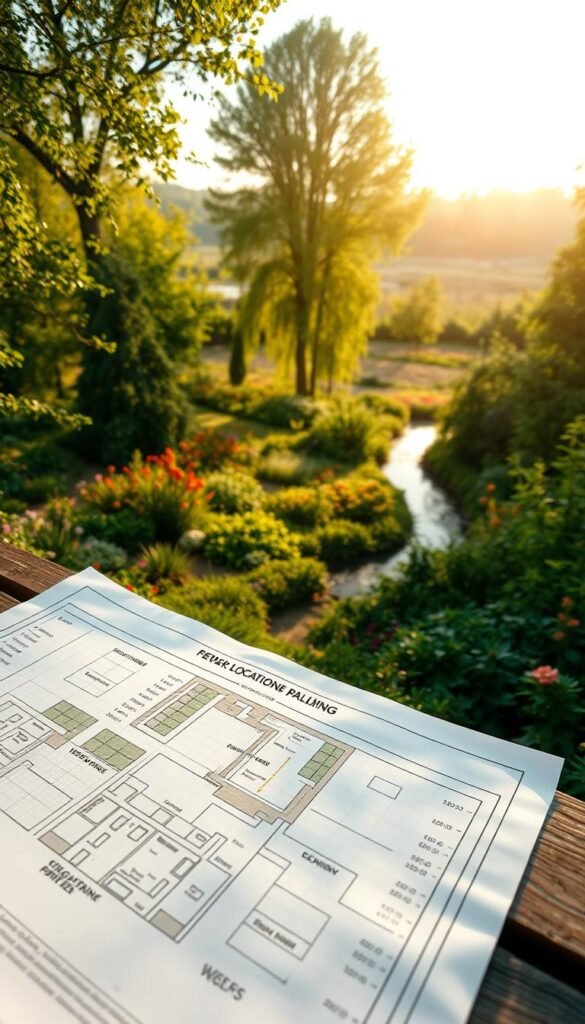
Your garden’s success begins with choosing the right location. Whether you’re planting a vegetable garden or herbs, three factors dominate: sun, water, and space. Get these right, and your plants will thrive with minimal fuss.
Assessing Sunlight, Water Flow, and Space
Most crops need 6–8 hours of direct sun daily. Track shadows using free apps or simply observe the area over a few days. South-facing spots often get 2+ extra sunlight hours—ideal for heat-loving tomatoes or peppers.
Test drainage by digging a 12-inch hole and filling it with water. If it takes over 4 hours to drain, amend the soil with compost. Poor drainage drowns roots, while fast drainage may need moisture-retaining mulch.
Choosing Your Growing Space: Ground, Containers, or Raised Beds?
Ground planting works for large areas but requires soil prep. Containers (12+ inches deep for tomatoes) suit patios. Raised beds cost 30% more but cut weeding by 60% and warm soil faster in spring.
For accessibility, raised beds with 24-inch heights accommodate wheelchair users. Cedar planks resist rot for DIY builds—avoid treated wood near edibles.
Greenhouses and Season Extenders
Plastic greenhouses add 6–8 weeks to your growing season. Budget options like hoop houses or cold frames protect tender leaves from frost. Position them near windbreaks (fences or shrubs) to stabilize temperatures.
Microclimates matter: Sloped areas avoid frost pockets, while walls reflect heat. Extend harvests year-round with smart placement and simple tools.
How to Start an Organic Garden: Soil, Seeds, and Care
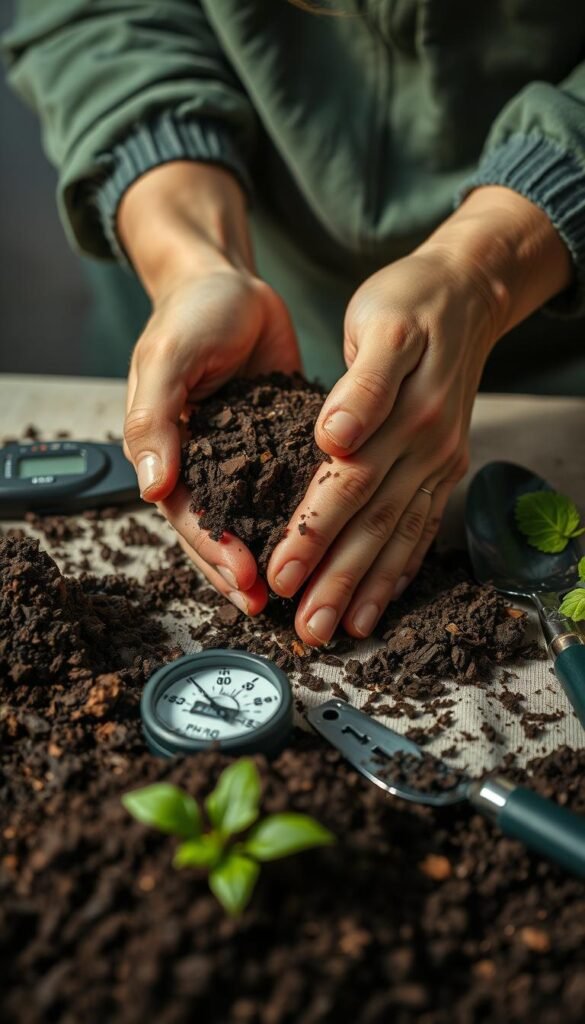
Healthy plants begin with nutrient-rich earth beneath them. Before planting, test and prepare your soil to create the perfect home for roots. A little effort now saves time and boosts yields later.
Testing and Preparing Your Soil
Start with a simple pH test. Mix a spoonful of soil with vinegar (fizzes = alkaline) or baking soda (fizzes = acidic). Ideal pH ranges from 6.0 to 7.0 for most crops.
Local extension offices offer detailed test kits. These reveal nutrient levels and recommend amendments like lime or sulfur.
No-Dig vs. Traditional Soil Preparation
No-dig methods build fertile layers without disturbing earth. Spread 3 inches of compost yearly to suppress weeds and feed microbes. This mimics natural forest floors.
Traditional digging aerates but exposes 10,000 weed seeds per square foot. Choose no-dig for less maintenance and better long-term soil structure.
The Role of Compost and Organic Matter
Compost is black gold for gardens. It adds organic matter, improving drainage and moisture retention. Try lasagna gardening: layer cardboard, straw, and kitchen scraps for instant beds.
- Brew compost tea to boost microbial life.
- Use sheet mulching to smother grass naturally.
- Vermicomposting fits small spaces with worms.
Mycorrhizal fungi partnerships help roots absorb nutrients. Work them into planting holes for stronger crops.
Selecting the Right Plants for Your Garden
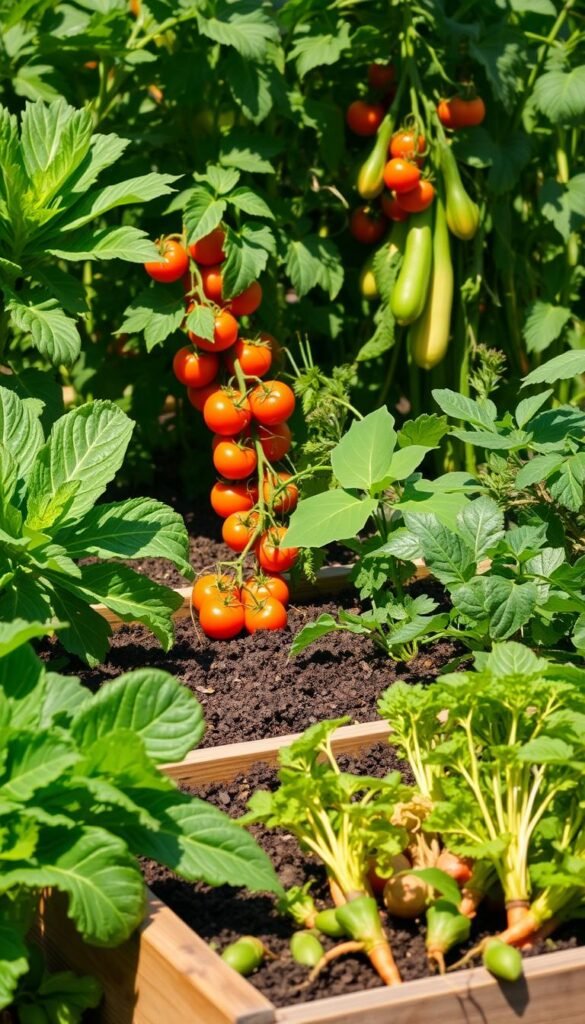
The right plants can turn your patch into a thriving oasis with minimal effort. Focus on varieties that suit your climate and skill level. A thoughtful mix ensures steady harvests and fewer pests.
Easy-to-Grow Vegetables for Beginners
Start with foolproof picks like kale, radishes, and bush beans. These tolerate imperfect conditions and mature quickly. Radishes, for example, sprout in just 3–5 days.
Heirloom seeds offer unique flavors but may need extra care. Hybrids often resist diseases better. Test seeds’ viability by placing them on a damp paper towel—discard any that don’t sprout within a week.
Organic Seeds vs. Seedlings: Pros and Cons
Organic seeds have a 90% higher germination rate than conventional ones. Starting from seed saves $3–$5 per plant but requires patience. Seedlings give you a head start but limit variety.
| Factor | Organic Seeds | Seedlings |
|---|---|---|
| Cost | $0.50–$3 per packet | $3–$8 per plant |
| Time to Harvest | Longer (6–12 weeks) | Shorter (2–4 weeks) |
| Variety | Wider selection | Limited to nursery stock |
Companion Planting for Healthier Crops
Pairing certain plants deters insects and boosts growth. Marigolds repel nematodes by 75%, while basil enhances tomatoes’ flavor. Try the “Three Sisters” method—corn supports beans, and squash shades the soil.
Rotate crops yearly to prevent soil depletion. Follow leafy greens with heavy feeders like tomatoes. This mimics nature’s balance and keeps your garden productive.
Planting and Nurturing Your Garden
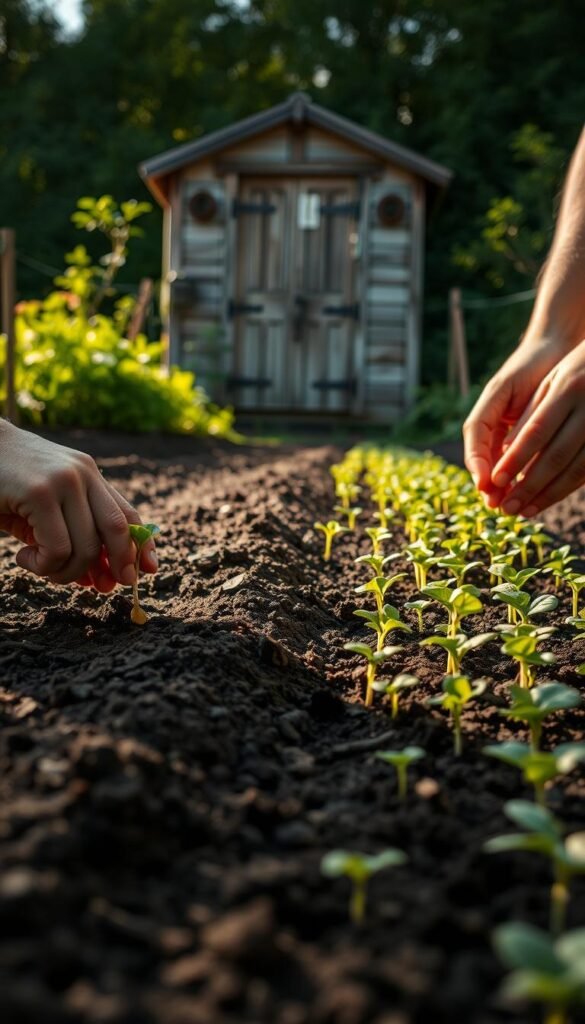
Getting your plants in the ground is just the beginning. Proper techniques ensure strong roots, steady growth, and bountiful harvests. Timing, preparation, and care make all the difference.
When and How to Sow Seeds
Check your local frost dates before planting. Cool-weather crops like spinach thrive in early spring, while tomatoes need warm soil. Direct sowing works best for fast growers like radishes—just press seeds ½ inch deep.
For slow starters, indoor sowing gives a head start. Use biodegradable pots to avoid root disturbance. A simple chart helps:
| Vegetable | Seed Depth | Days to Germinate |
|---|---|---|
| Lettuce | ¼ inch | 5–10 |
| Carrots | ½ inch | 14–21 |
| Beans | 1 inch | 7–14 |
Hardening Off Seedlings for Outdoor Growth
Transition indoor-grown plants gradually over 7 days. Start with 1 hour of morning sun, increasing exposure daily. This prevents shock—80% of transplants fail without hardening.
Protect tender leaves with DIY cloches. Cut milk jugs in half and place them over seedlings at night. Remove them during the day to prevent overheating.
Watering and Mulching for Optimal Moisture
Drip irrigation cuts water use by 50% compared to sprinklers. Check soil moisture with the finger test—if dry 2 inches down, water deeply. Morning watering reduces evaporation.
Straw mulch keeps roots cool in summer. Apply a 3-inch layer, leaving space around stems to prevent rot. For container gardens, try self-watering pots to maintain consistent hydration.
- Seedlings: Water daily for the first week
- Established plants: 1–2 inches per week
- Drought-tolerant herbs: Let soil dry slightly between waterings
Organic Pest and Weed Control
Nature provides simple solutions to keep your garden thriving without harsh chemicals. By working with ecosystems—not against them—you’ll deter pests and weeds sustainably. These methods protect soil health and pollinators while delivering lush results.
Attracting Beneficial Insects
Ladybugs devour 5,000 aphids in their lifetime. Encourage these helpers by planting dill, fennel, or yarrow. A DIY insects hotel with bamboo tubes and wood scraps offers shelter for lacewings and bees.
- Companion plants: Marigolds repel nematodes; basil deters flies.
- Avoid broad-spectrum sprays—they harm pollinators.
- Leave shallow water dishes for insects to drink.
Natural Remedies for Common Pests
Neem oil disrupts pests’ life cycles without harming earthworms. Mix 1 tsp per quart of water and spray at dawn. For slugs, bury a cup of beer—they’ll crawl in overnight.
Copper tape around pots stops snails. Diatomaceous earth (food-grade) scratches soft-bodied insects but wears off after rain.
Weed Management Without Chemicals
Corn gluten meal prevents 80% of weeds by blocking germination. Apply in early spring. For stubborn patches, solarization (covering lawn with clear plastic for 6 weeks) cooks seeds with heat.
- Flame weed seedlings carefully—avoid dry foliage.
- Mulch with straw or cardboard to smother growth.
- Hand-pull after rain when roots loosen.
Feeding Your Garden Naturally
Your plants thrive when nourished with the right nutrients. Unlike synthetic options, organic methods build long-term soil health while producing vibrant crops. The secret? Working with nature’s cycles to create a self-sustaining system.
Organic Fertilizers and Soil Amendments
Compost tea delivers a balanced 10-10-10 NPK ratio naturally. Brew it by steeping compost in water for 48 hours. This liquid gold boosts microbial activity and nutrients uptake.
Banana peels soaked in water for 3 days create potassium-rich fertilizer. For calcium, crush eggshells into planting holes. Worm castings offer 5 times more nitrogen than standard organic fertilizers.
Crop Rotation and Soil Health
Rotating crops annually prevents nutrient depletion. Follow heavy feeders like tomatoes with nitrogen-fixing beans. A 4-year plan increases yields by 20% each year.
Leafy greens rebuild matter after fruiting plants. Track rotations with a simple journal or app. This mimics natural ecosystems while reducing pests.
Using Green Manures and Cover Crops
Clover and vetch add 4-6 tons of organic matter per acre. Sow them in fall, then till under in spring. These “living fertilizers” prevent erosion and suppress weeds.
For quick results, try buckwheat—it matures in 30 days. Mustard releases natural fungicides as it decomposes. Learn more about soil-building techniques from agricultural experts.
Enjoying the Harvest and Beyond
Your hard work pays off when crisp greens and ripe tomatoes fill your basket. Succession planting stretches the harvest by months—sow quick growers like radishes between slower crops. Freezing or blanching locks in 90% of nutrients, so summer flavors last through winter.
Spot peak ripeness easily. Tomatoes detach with a gentle twist. Zucchini tastes best at 6–8 inches long. For pumpkins, check for hardened stems and tough skins. Leafy greens sweeten after light frosts.
Preserve extras with simple methods. Canning suits tomatoes, while dehydrating works for herbs. Share extras with neighbors or local food banks—it builds community ties.
Plan ahead for next season. Save seeds from your healthiest plants. Track progress with a journal, noting what thrived. Winter prep includes mulching beds and clearing debris.
Reflect on wins and lessons. Each year, your skills grow alongside your plants. The joy of fresh, homegrown meals never ends.






